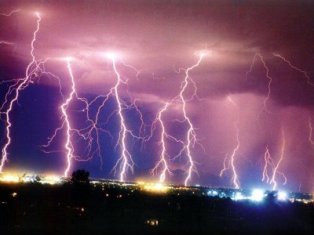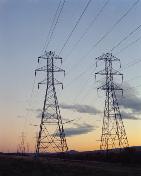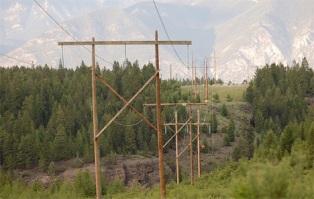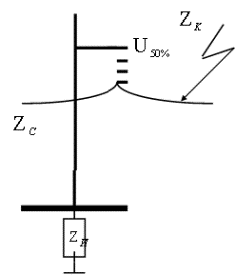Lightning protection of overhead power lines
An overhead power line is the longest element of the electrical system. It is also the most common element of the system and most often struck by lightning. Power system accident statistics show that 75-80% of overhead power line emergency outages are related to lightning outages.
Physics of Lightning Discharge
Lightning - a type of gas discharge with a very long spark length. The total length of the lightning channel reaches several kilometers, and a significant part of this channel is located inside the thundercloud.
For a thunderstorm to occur, firstly, strong updrafts and, secondly, the necessary air humidity in the area of thunderstorms.
Updrafts occur due to heating of air layers adjacent to the earth's surface and thermally induced heat exchange of these layers with cooler air at high altitudes.
In the cloud, several accumulations of charges are formed, isolated from each other (in the lower part of the cloud, charges of negative polarity accumulate), lightning is usually multiple, i.e. consists of several single discharges developing along the same path.
The exact mechanism of charge separation in a thundercloud is still largely unclear. However, observations show that the charge separation coincides with the freezing of water droplets in a cloud.

The allowable number of interruptions of overhead power lines as a result of lightning
The feasibility study shows that it is impossible to make overhead power lines absolutely lightning-proof... We must deliberately assume that overhead power lines will be shut down a limited number of times a year. The task of lightning protection of power lines is to minimize the number of lightning interruptions.
Permissible number of suspension of overhead power lines per year and additional shutdown is determined by the conditions:
a) reliable power supply to consumers,
b) reliable operation of switches traveling to overhead power lines and is calculated by the formula:

where nadditional — the number of allowable interruptions in the power supply on the line per year nadd ≤ 0.1 in the absence of redundancy and nadd ≤ 1 if redundant is available), β — APV success rate equal to 0.8-0.9 for lines 110 kV and higher on metal and reinforced concrete supports.
 Automatic recloser (AR) can keep the line in operation as cases of insulation failure of arcing supports are quite rare. In this case, the lightning strike will not be accompanied by a power outage.In the event of failure of automatic reconnection, a complete shutdown of the power line will occur.
Automatic recloser (AR) can keep the line in operation as cases of insulation failure of arcing supports are quite rare. In this case, the lightning strike will not be accompanied by a power outage.In the event of failure of automatic reconnection, a complete shutdown of the power line will occur.
It should be noted that the frequent use of automatic reclosing complicates the operation of circuit breakers, which in this case require extraordinary revision. Based on this, it is allowed to have nadditional shutdown = 1 — 4 depending on the type of switches. For critical lines, this number of trips should be reduced.
Estimated number of lightning strikes on overhead power lines
The expected number of lightning outages on the line is mainly determined by the intensity of lightning activity in the area of the line route. Based on the average figures, it is generally accepted that 0.067 lightning strikes occur at 1 km from the earth's surface in one thunderstorm hour... Given that the line collects all strikes from a strip of width 6h (h is the average height of a cable suspension or cable), the number of N lightning strikes on a line of length l per year is
N = 0.067 × n × 6h × l × 10-3 ,
where n is the number of thunderstorm hours per year.
The number of overlaps in the insulation of overhead power lines is determined by the formula
ntape = n NS Pcloth,
where Pln — the probability of overlap of the line insulation at a given lightning current.
Not every overlap of impulse isolation is accompanied by a line shutdown, since tripping requires the passage of an impulse arc to the supply arc. The transition probability depends on many factors, and in engineering calculations it is customary to determine it by the gradient of the operating voltage along the overlap path EСр = Urob / Lband, kV / m.

For lines on wooden supports with long air gaps, the probability of switching to a pulsed arc h is determined by the formula

For lines on metal and reinforced concrete supports, h = 0.7 for line voltage up to 220 kV and h = 1.0 for nominal voltage 330 kV and more.
Multiplying the nlent by a factor η, it is possible to calculate the expected number of lightning strikes on the line per year

In engineering practice, the specific number of line breaks nNumber of breaks per 100 km of line passing through an area with 30 hours of thunderstorms per year is usually used:

To reduce the number of lightning strikes on the line, you can:
-
reducing the probability of insulation overlapping during lightning strikes, which is usually achieved on overhead power lines with metal supports by suspending lightning rods from contact wire and by providing low impulse grounding resistance of supports and cables,
-
extend the overlap path with a low operating voltage gradient, which reduces the coefficient h of the impulse arc to power arc transition. The latter is performed on overhead power lines with wooden supports.
Effect of lightning protection performance
Overhead power lines on metal (reinforced concrete) supports without a ground wire.

When the wire is struck at the point of impact, a resistance equal to half the characteristic impedance of the Z wire is turned on.
